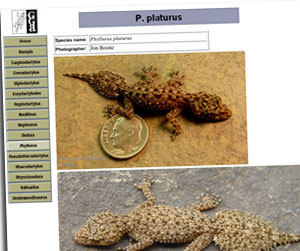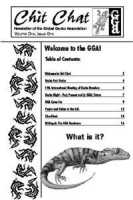[ad#superworm]
What is the Global Gecko Association?
The Global Gecko Association (GGA) is an educational 501-c3 non-profit organization solely dedicated to the gecko enthusiast, from amateur to professional. It accomplishes its educational goals using its publications, Gekko, a scholarly journal, Chit-Chat, a less formal periodical, and a large website featuring over 1,000 gecko photographs as well as a wealth of gecko information.
Mission

From the GGA constitution: “The Global Gecko Association is organized exclusively for educational and advocacy purposes to promote general interest, education and conservation of Gekkota globally, and providing for members a vehicle for the exchange and sharing of resources, information, and ideas relating to all aspects of Gekkota.” Advocacy of responsible gecko ownership is also part of the mission as well as monitoring legislation concerning geckos at all levels.
Who is the GGA? Board and Membership
Membership is available at multiple levels from the individual to institution and consists of enthusiasts in every niche from hobbyist to herpetologist world-wide. The current board and staff are comprised of folks from Canada, France, Italy, Poland, the United Kingdom, and the United States of America. All board members volunteer countless hours of their time for their passion, geckos! Many have served long-term and have worked in multiple positions during their tenure on the board such as Lyle Puente (past president, publications editor), Leann (current archivist) and Greg Christenson (past webmaster/list-serve manager), Neil Meister (current publications), John Rudge (editor, current publications), and Chris Nelling (current treasurer).
History

The GGA was formed as a direct result of the demise of the International Gecko Society (IGS). The IGS had the same essential goals, to serve and educate the gecko community and had its own scholarly publication, Dactylus. The GGA and IGS were often mistaken as one and the same organization as a result of this similarity. When the GGA was formed in 1997, the dedicated group of founding members, many of who still are active in the organization today, were determined to do all the IGS accomplished, educating its members with a high quality journal, and much, much more. To this end, the GGA began a spirited journey into many forms of communication with the international gecko community.
The GGA was the first gecko society to use the internet to allow their members to communicate with each other with the ground breaking “gecko listserve”, the creation of longtime GGA webmaster Greg Christenson. The gecko listserve, an e-mail list, was open to anyone who wanted to join and quickly became the best place to come and learn about and get help with geckos from gecko keepers around the world! Instant global communication became reality, and then eventually the various online gecko forums such as Geckos Unlimited and the Gecko Resource forums evolved into a more sophisticated method of online communication.
In the early days of the GGA, lifetime member Wayne Hill made it possible for the GGA to put an event on called “Gecko Night” at his National Reptile Breeders’ Expo. Speakers like GGA members Yuri Kaverkin from Russia and Grant Macredie from New Zealand brought an international crowd, and for several years when the event was held it was a huge success. One year a video was made of the talks, providing the GGA yet another mode of education for the membership.
[ad#sponsor]
The Tools of Member Education
Gekko is the flagship publication of the GGA. It is a sophisticated, academically-oriented educational tour de force written and coveted by gecko enthusiasts world-wide. In full color, Gekko offers the reader detailed accounts of gecko captive breeding, taxonomy, ecology as well as interesting gecko phenomena like the ability to walk upside down! Gekko articles are frequently written by people who live in or frequently visit the natural habitats of the geckos they write about. Rob Porter, a frequent contributor, comes to mind with his highly sought after articles on all geckos Australian including the popular genus’s Nephrurus and Phyllurus (the other “Uroplatus” from down under). Members Jon Boone and Bruce Gates also come to mind with their travels to Africa to write about geckos such as Pachydactylus and Chondrodactlyus living there. Noted gecko breeders contributing articles to Gekko read like a who’s who list in the gecko world; Neil Meister (Uroplatus, Goniurosaurus), Phil Tremper (arboreal gecko specialist), Tim Tytle (Phelsuma pioneer), and Yuri Kaverkin (any gecko genus rare and cool!) just to name a few. Respected herpetologists such as Aaron Bauer and L. Lee Grismer have also contributed articles to Gekko.
Chit-Chat is the GGA’s newsletter-type black and white periodical. This publication is named after the sound made by perhaps the most successful gecko world-wide, Hemidactylus frenatus, the common “house gecko.” Chit-Chat is more causal reading than Gekko, and is just as information packed! It is full of all kinds of useful information regarding anything gecko besides having popular regular and semi-regular features. One of my favorite features is “Helpful Hints”. Chit-Chat volume 4 had a hint contributed by R. Michael Burger of the San Antonio Zoo to use guitar picks to pry open the mouths of small geckos for the purposes of feeding and medicating them. Another popular feature is the “Gecko Fact Finder” which has the goal, taken directly from the GGA constitution, “to facilitate closer cooperation between those interested in Gekkonids at both the amateur and professional level.” Various journal articles, books and magazine publications are summarized and reviewed for the reader, saving them countless hours of library research and keeping them abreast of the “latest” gecko research. Also intriguing is the beautiful gecko artwork interspersed throughout the publication, sometimes asking the reader to identify the subject!
The GGA website – www.gekkota.com is also a great educational tool. As already mentioned there is a gecko photo gallery with countless pictures of geckos providing a useful tool to identify and properly classify any gecko in question. There is a page of gecko sounds carefully preserved for the enthusiast to learn more about another characteristic that makes geckos unique, their ability to vocalize. There are care sheets written by members, and free classifieds for the captive bred gecko offspring produced by the membership. There is also a useful links section to all that is relevant and interesting to the gecko enthusiast, and finally, Bibliogek, the GGA’s member bookstore. Bibliogek is run by GGA archivist and long time board member Leann Christenson. Through Bibliogek members can purchase desirable gecko publications such as books and individual papers at a discount. Some back issues of Gekko are still available.
Future plans
As I am writing this article GGA webmaster Brittney Gougeon is busy preparing a brand-new website for the GGA which should kick off the new decade in grand style! The new website will be more modern and user-friendly. The GGA has also ventured into new territory with a new Facebook Group to communicate with gecko enthusiasts in yet another mode! In the years to come the GGA will look for more ways to communicate with its members using social networking and other forms of media. Also anticipated is the revival of “Gecko Night” and an increased presence of the GGA at world-wide reptile shows and events with the use of Regional Representatives (please apply if you are interested!).
The GGA offers the ultimate gecko enthusiast’s package: gecko education and information from every possible angle, from publications to website! The GGA was created by the gecko community for the gecko community, so join, start writing articles and get involved!



I met Neil last year and he is a great guy full of knowledge
Awesome article, Julie! The GGA is a wealth of knowledge, I’m so pleased to see Gecko Time involved with the GGA. 🙂
Please help! I found a baby Mediteranian Gecko at school but I have no idea what to feed it! It is injured in the arm with what looks like internal bleeding, but it can move its arm. I don’t want this cute creature to die! Please help, Gecko Masters!
This article was inspiring
By Maddie Rivera